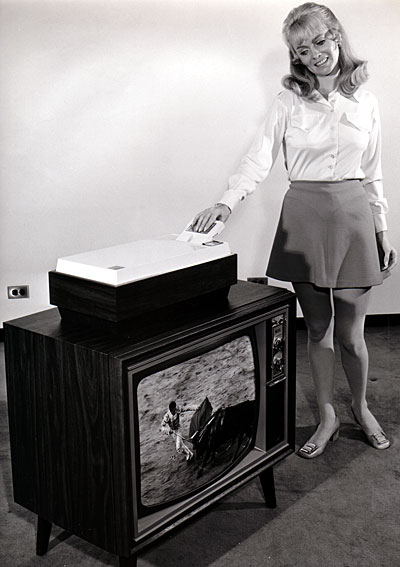
 |
Search | FAQ | US Titles | UK Titles | Memories | VaporWare | Digest | |||||||
| GuestBook | Classified | Chat | Products | Featured | Technical | Museum | ||||||||
| Downloads | Production | Fanfares | Music | Misc | Related | Contact | ||||||||
| CED in the History of Media Technology | ||||||||||||||

RCA's competitive system to CBS's EVR was initially called HoloTape, and was later renamed SelectaVision or SV. This represents the first use of the word SelectaVision, which RCA later applied to their aborted MagTape system and, of course, to the CED system. During this period RCA was also using the acronym PREVS (PRerecorded Electronic Video Systems) to encompass all present and future consumer video systems. Like EVR, Holotape was a playback only format using what was believed would be an inexpensive mastering process. RCA gave a color HoloTape demonstration on September 30, 1969, but the system still lacked sound.
Holotape used electron beam recording to make a color encoded master of high resolution. A laser beam was then split, with one beam directed through the master and the other directly onto a plastic tape coated with photoresist- a material that hardens in direct ratio to the light that strikes it. When the two beams intersected on the tape surface, interference patterns (holograms) were formed in the photoresist that encoded all the information needed to reconstruct the video image. The tape was then chemically treated to eat away the photoresist not hardened by the laser beam. The resulting hologram master looked like a relief map of hills and valleys. A coating of nickel was plated on the hologram master resulting in a nickel master. A finished Holotape was made by feeding a sandwich composed of the nickel master and vinyl tape through high pressure rollers. RCA claimed thousands of finished tapes could be made from one nickel master. The home playback deck contained a low power laser whose beam was directed through the tape to a video imager also inside the deck.
Although Holotape may have eventually been a manufacturable system, it needed a lot more research to reach that state after the 1969 demo. Development of the system did continue until June 1972, when it was canceled in the wake of RCA's huge financial loss from selling its troublesome computer division to Univac.